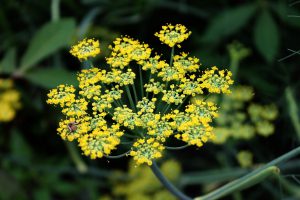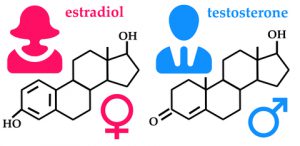Setting the Saga Straight with Science: Hormonal Effects and Essential Oils

The Basics on Fennel Oil
In my recent series that was spurred by a badly extrapolated study on tea tree and lavender oils, I’ve been reviewing the safety of essential oils for hormonal and whole-body health. I have highlighted the basics on assessing studies’ conclusions as reported in the media and the importance of differentiating essential oils’ mechanisms in humans versus petri dishes or rodents. I’ve also discussed why it is imperative to use quality, uncontaminated essential oils that are not polluted with plasticizers. (source, source, source) This would be a classic case of the wrong witness being convicted for endocrine disruption.
After understanding the basics on essential oil’s synergistic actions in humans, I started highlighting specific essential oils. First, I reported on the balancing properties of clary sage, including its use for menopausal, menstrual, and labor symptoms. I also explained why the essential oil is not “estrogenic,” and the claims were mostly based on one isolated constituent, sclareol.
Most recently, I began looking at the many benefits of fennel oil. Similarly to clary sage oil, one compound found in fennel oil seemed to be its sticking point for full acceptance into the media’s good graces. I reviewed in detail this estragole debate, the “bad” constituent in fennel oil, and how with proper use, dosage, and a high quality essential oil, the safety concern is unfounded.
Fennel is a perfect example of an oil’s synergism and balancing properties in the human body when it has all of its compounds intact. It perfectly demonstrates that claims based on one component, which is extracted from the hundreds, will not have the same outcome as the pure essential oil. Furthermore, in the case of estragole, there are elimination and biotransformation differences in the liver of humans versus rats, making toxicity claims based on critters unreliable. (source, source, source) Finally, certain chemotype variations (differences of percentage of the constituents present) may have higher levels of “unwanted” compounds. This is minimized by quality and standardized fennel oils, decreasing the concern for over dosage with suggested amounts when trusted brands are used.
In my previous review of fennel oil, I highlighted that is has studies to support its benefits for use for lactation in humans and for a spasming uterus in PMS rodents. You can read a summary of all its other benefits, from respiratory to digestive health, in the articles here and here.
Now, we’ll continue our journey with fennel essential oil, specifically focusing on the hormonal effects that it is deemed to promote. (source, source, source)
The (Hormonal) Balancing Actions of Fennel Oil versus Manipulation by Isolated Compounds

As noted above, there is a synergism to essential oils that creates harmony in the body. Whereas scientists are claiming the dangers of fennel oil due to estragole’s potential toxic effects, a balancing compound in fennel, anethole has been found to have tumor suppressor activity in petri dishes with human cancer cells. (Do you see how isolating one compound won’t tell the whole story?)
This is relevant to the hormonal controversy because anethole was deemed to potentially affect estrogen levels. In an abstract from the 2009 Thirty-Second Annual CTRC‐AACR San Antonio Breast Cancer Symposium, the authors stated that this compound supported sensitization to human breast cancer cells to chemotherapy. They stated in their conclusion published in Cancer Research:
These data suggest that the anethole is a potential anti-tumor agent, and that co-treatment of tamoxifen and anethole is a potential approach to sensitize human breast MCF-7 cells to tamoxifen treatments.
Although they noted potential estrogenic activity, it was inconclusive. This is probably due to all the factors I stated above regarding the biases that exist with petri dish studies and petrochemical contamination. (source, source, source)
To bring this point home of the conflicting findings that result with plasticizers found in petri dish trays, another, more recent, 2012 in vitro study published in Phytomedicine found anethole to have antitumoral properties independent of estrogen receptor activity. The authors stated:
In conclusion, anethole in an ER independent manner suppresses cell survival and induces apoptotic events in MCF-7 and MDA-MB-231 at an optimal concentration of 1 × 10(-3) M. In search of alternative compounds for therapeutic development, this study has demonstrated that anethole may be viable as an anti-cancer agent through the modulation of apoptosis, cell survival and proliferation in breast cancer cells.
AND…
Another study in a petri dish found anethole to be effective on triple negative breast cancer cells, supporting healthy cells, not the other way around. (Access this full study here.)
So, now we’ve hit a homerun demonstrating that it is not valid to evaluate or makes claims about an essential oil based on the sum of its parts. AKA, the sum is not equal to the whole. (Any Aristotle fans?)
We also must consider metabolism in the body and its metabolites actions, this is why clinical trials are so important. One study states that it isn’t even anethole that has the effects in fennel oil, rather its pharmacologically active polymers, such as dianethole and photoanethole. (Wikki says, “A polymer is a large molecule, or macromolecule, composed of many repeated subunits.”) This has now caused some to make claims that these are estrogenic, but here’s my caveats:
- Again, as noted above, you can’t say one isolated component or metabolite will have the same action as the essential oil.
- I have to ask, “Does your fennel oil even contain polymers?”
Usually, polymerization occurs in poorly distilled oils or degradation of them from poor storage. (source) (Learn more about expiration dates and essential oils here.)
I don’t worry about polymerization in my oils, just sayin.’
Do you see why really knowing the biochemistry and evaluating the essential oil is more important versus just the effects in petri dishes? (source)
Finally, a study with rodents assessed if fennel oil had a protective role against kidney damage. According to the authors, research has suggested that estrogen is a risk factor for chronic kidney disease and is not protective from induced damage. What did the researchers find? Fennel oil did not promote damage or protect the kidneys. The authors were unable to make conclusions on its mechanisms. Although, like estrogen, it was not protective, estrogen was shown in previous studies to promote kidney damage. Fennel oil did not.
Being an in vivo study eliminates the petri dish issue, and using the essential oil takes out the biases of isolating one compound. We still need to consider that this a rat study, not human trial. Rodents do not metabolize compounds as humans.

The Bottom Line
The bottom line has not moved up from the clary sage article’s conclusion.
I’ll repeat it.
Essential oils have synergism and balance the body.
There is some evidence in rodents that fennel EXTRACT may modulate estrogenic activity; whereas fennel oil didn’t in this comparison study. Another study showed the acetone extract also may have estrogenic effect in rodents. Even with these in vivo results, we should be cautious with comparing critter outcomes to human effects.
Summary
When essential oils are used properly and in correct doses, the individual is likely to have a response that promotes healing and wellness. It is unlikely that fennel oil is “estrogenic,” and we have seen clinical trials where it is helpful, not harmful, for the endocrine system.
Speaking of fennel oil, it’s included in this month’s promotions! Read more about them here.
Now…onto Sage Oil… Sage Oil- Memory in the Name, Are Hormonal Actions in its Game? Click here.
I, or of my personally selected leader based on your inquiry, will follow up with you within a few days of your contact and/or your first order!
Many blessings from my heart to yours!
This material is for information purposes only and is not intended to diagnose, treat, or prescribe for any illness. You should check with your doctor regarding implementing any new strategies into your wellness regime. These statements have not been evaluated by the FDA. (Affiliation link.)
Disclaimer: This information is applicable ONLY for therapeutic quality essential oils. This information DOES NOT apply to essential oils that have not been tested for purity and standardized constituents. There is no quality control in the United States, and oils labeled as “100% pure” need only to contain 5% of the actual oil. The rest of the bottle can be filled with fillers and sometimes toxic ingredients that can irritate the skin. The studies are not based solely on a specific brand of an essential oil, unless stated. Please read the full study for more information.
Thanks Pixabay and iStock purchases.



